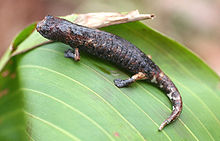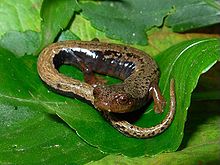Mushroom Tongue Salamander
| Mushroom Tongue Salamander | ||||||||||||
|---|---|---|---|---|---|---|---|---|---|---|---|---|

Mexican climbing salamander ( Bolitoglossa mexicana ) |
||||||||||||
| Systematics | ||||||||||||
|
||||||||||||
| Scientific name | ||||||||||||
| Bolitoglossa | ||||||||||||
| Dumeril , Bibron & Dumeril , 1854 |
The bolitoglossa or climbing Salamander ( Bolitoglossa ) are a genus of Caudates . They belong to the lungless salamander family and are common in Central and South America . The mushroom-tongue salamanders are the largest genus of the salamanders and, with more than 130 species, comprise around a quarter of the species diversity of this order.
features
The head-torso length of the adult salamander is between 3 and 20 centimeters, depending on the species. The mushroom-tongue salamanders have four toes on the front limbs and five on the back. Around half of the species have webbed toes. It used to be the opinion that the webbed feet were an adaptation to life on trees and in bromeliad funnels and improved adhesion to the leaves. However, according to recent research, the webbed feet could represent a form of pedomorphosis . Juvenile characteristics that played a role in the ancestors of the mushroom-tongue salamanders are retained. This is also indicated by other pedomorphic characteristics of many species of the genus. These webbed forms also occur in purely terrestrial forms.
distribution
The range of the mushroom-tongue salamander ranges from Mexico to Central America, where a particularly large variety of species was discovered in Costa Rica and Panama , to Colombia , Venezuela , Ecuador , Peru , northeast Brazil and Bolivia .
Taxonomy
The genus was in 1854 by Gabriel Bibron , André Marie Constant Duméril and his son Auguste Henri André Duméril in Volume 9 of its overall work on the natural history of reptiles and amphibians Erpétologie Genérale ou Histoire Naturelle des Reptiles Complète first described . The assignment of the type species Bolitoglossa mexicana for the genus Bolitoglossa was made retrospectively in 1944 by Taylor.
The genus Bolitoglossa is counted along with many other related genera to the tribe Bolitoglossini .
species
In 2012 121 species were described. In 2013 and 2014, 9 new species were added. Another species was first described in 2016 , as well as in 2017 and 2019 (2020). A total of 133 species belong to the genus Bolitoglossa (mushroom tongue salamander).
As of March 16, 2020
- Bolitoglossa adspersa (Peters, 1863)
- Bolitoglossa alberchi García-París, Parra-Olea, Brame & Wake, 2002
- Bolitoglossa altamazonica (Cope, 1874)
- Bolitoglossa alvaradoi Taylor, 1954
- Bolitoglossa anthracina Brame, Savage, Wake & Hanken, 2001
- Bolitoglossa aurae Kubicki & Arias, 2016
- Bolitoglossa aureogularis Boza-Oviedo, Rovito, Chaves, García-Rodríguez, Artavia, Bolaños & Wake, 2012
- Bolitoglossa biseriata Tanner, 1962
- Bolitoglossa borburata Trapido, 1942
- Bolitoglossa bramei Wake, Savage & Hanken, 2007
- Bolitoglossa caldwellae Brcko, Hoogmoed & Neckel-Oliveira, 2013
- Bolitoglossa capitana Brame & Wake, 1963
- Bolitoglossa carri McCranie & Wilson, 1993
- Bolitoglossa cataguana Townsend, Butler, Wilson & Austin, 2009
- Bolitoglossa celaque McCranie & Wilson, 1993
- Bolitoglossa centenorum Campbell, Smith, Streicher, Acevedo & Brodie, 2010
- Bolitoglossa cerroensis (Taylor, 1952)
- Bolitoglossa chica Brame & Wake, 1963
- Bolitoglossa chucantiensis Batista, Koehler, Mebert & Vesely, 2014
- Bolitoglossa chinanteca Rovito, Parra-Olea, Lee & Wake, 2012
- Bolitoglossa colonnea (Dunn, 1924)
- Bolitoglossa compacta Wake, Brame & Duellman, 1973
- Bolitoglossa conanti McCranie & Wilson, 1993
- Bolitoglossa copia Wake, Hanken & Ibáñez, 2005
- Bolitoglossa copinhorum Itgen, Sessions, Wilson & Townsend, 2020 "2019"
- Bolitoglossa cuchumatana (Stuart, 1943)
- Bolitoglossa cuna Wake, Brame & Duellman, 1973
- Bolitoglossa daryorum Campbell, Smith, Streicher, Acevedo & Brodie, 2010
- Bolitoglossa decora McCranie & Wilson, 1997
- Bolitoglossa diaphora McCranie & Wilson, 1995
- Bolitoglossa digitigrada Wake, Brame & Thomas, 1982
- Bolitoglossa diminuta Robinson, 1976
- Bolitoglossa dofleini (Werner, 1903)
- Bolitoglossa dunni (Schmidt, 1933)
- Bolitoglossa engelhardti (Schmidt, 1936)
- Bolitoglossa epimela Wake & Brame, 1963
- Bolitoglossa equatoriana Brame & Wake, 1972
- Bolitoglossa eremia Campbell, Smith, Streicher, Acevedo & Brodie, 2010
- Bolitoglossa flavimembris (Schmidt, 1936)
- Bolitoglossa flaviventris (Schmidt, 1936)
- Bolitoglossa franklini (Schmidt, 1936)
- Bolitoglossa gomezi Wake, Savage & Hanken, 2007
- Bolitoglossa gracilis Bolaños, Robinson & Wake, 1987
- Bolitoglossa guaneae Acosta-Galvis & Gutiérrez-Lamus, 2012
- Bolitoglossa guaramacalensis Schargel, García-Pérez & Smith, 2002
- Bolitoglossa hartwegi Wake & Brame, 1969
- Bolitoglossa heiroreias Greenbaum, 2004
- Bolitoglossa helmrichi (Schmidt, 1936)
- Bolitoglossa hermosa Papenfuss, Wake & Adler, 1984
- Bolitoglossa hiemalis Lynch, 2001
- Bolitoglossa huehuetenanguensis Campbell, Smith, Streicher, Acevedo & Brodie, 2010
- Bolitoglossa hypacra (Brame & Wake, 1962)
- Bolitoglossa indio Sunyer, Lotzkat, Hertz, Wake, Aléman, Robleto & Köhler, 2008
- Bolitoglossa insularis Sunyer, Lotzkat, Hertz, Wake, Aléman, Robleto & Köhler, 2008
- Bolitoglossa jacksoni Elias, 1984
- Bolitoglossa jugivagans Hertz, Lotzkat & Köhler, 2013
- Bolitoglossa kamuk Boza-Oviedo, Rovito, Chaves, García-Rodríguez, Artavia, Bolaños & Wake, 2012
- Bolitoglossa kaqchikelorum Campbell, Smith, Streicher, Acevedo & Brodie, 2010
- Bolitoglossa la Campbell, Smith, Streicher, Acevedo & Brodie, 2010
- Bolitoglossa leandrae Acevedo, Wake, Márquez, Silva, Franco & Amézquita, 2013
- Bolitoglossa lignicolor (Peters, 1873)
- Bolitoglossa lincolni (Stuart, 1943)
- Bolitoglossa longissima McCranie & Cruz-Díaz, 1996
- Bolitoglossa lozanoi Acosta-Galvis & Restrepo, 2001
- Bolitoglossa macrinii (Lafrentz, 1930)
- Bolitoglossa Madeira Brcko, Hoogmoed & Neckel-Oliveira, 2013
- Bolitoglossa magnifica Hanken, Wake & Savage, 2005
- Bolitoglossa marmorea (Tanner & Brame, 1961)
- Bolitoglossa medemi Brame & Wake, 1972
- Bolitoglossa meliana Wake & Lynch, 1982
- Bolitoglossa mexicana Duméril, Bibron & Duméril, 1854
- Bolitoglossa minutula Wake, Brame & Duellman, 1973
- Bolitoglossa mombachoensis Koehler & McCranie, 1999
- Bolitoglossa morio (Cope, 1869)
- Bolitoglossa mucuyensis García-Gutiérrez, Escalona, Mora, de Pascual & Fermin, 2012
- Bolitoglossa mulleri (Brocchi, 1883)
- Bolitoglossa nicefori Brame & Wake, 1963
- Bolitoglossa nigrescens (Taylor, 1949)
- Bolitoglossa ninadormida Campbell, Smith, Streicher, Acevedo & Brodie, 2010
- Bolitoglossa nussbaumi Campbell, Smith, Streicher, Acevedo & Brodie, 2010
- Bolitoglossa nympha Campbell, Smith, Streicher, Acevedo & Brodie, 2010
- Bolitoglossa oaxacensis Parra-Olea, García-París & Wake, 2002
- Bolitoglossa obscura Hanken, Wake & Savage, 2005
- Bolitoglossa occidentalis Taylor, 1941
- Bolitoglossa odonnelli (Stuart, 1943)
- Bolitoglossa omniumsanctorum (Stuart, 1952)
- Bolitoglossa oresbia McCranie, Espinal & Wilson, 2005
- Bolitoglossa orestes Brame & Wake, 1962
- Bolitoglossa pacaya Campbell, Smith, Streicher, Acevedo & Brodie, 2010
- Bolitoglossa palmata (Werner, 1897)
- Bolitoglossa pandi Brame & Wake, 1963
- Bolitoglossa paraensis (Unterstein, 1930)
- Bolitoglossa peruviana (Boulenger, 1883)
- Bolitoglossa pesrubra Taylor, 1952
- Bolitoglossa phalarosoma Wake & Brame, 1962
- Bolitoglossa platydactyla (Gray, 1831)
- Bolitoglossa porrasorum McCranie & Wilson, 1995
- Bolitoglossa psephena Campbell, Smith, Streicher, Acevedo & Brodie, 2010
- Bolitoglossa pygmaea Bolaños & Wake, 2009
- Bolitoglossa ramosi Brame & Wake, 1972
- Bolitoglossa riletti Holman, 1964
- Bolitoglossa robinsoni Bolaños & Wake, 2009
- Bolitoglossa robusta (Cope, 1894)
- Bolitoglossa rostrata (Brocchi, 1883)
- Bolitoglossa rufescens (Cope, 1869)
- Bolitoglossa salvinii (Gray, 1868)
- Bolitoglossa savagei Brame & Wake, 1963
- Bolitoglossa schizodactyla Wake & Brame, 1966
- Bolitoglossa silverstonei Brame & Wake, 1972
- Bolitoglossa sima (Vaillant, 1911)
- Bolitoglossa sombra Hanken, Wake & Savage, 2005
- Bolitoglossa sooyorum Vial, 1963
- Bolitoglossa splendida Boza-Oviedo, Rovito, Chaves, García-Rodríguez, Artavia, Bolaños & Wake, 2012
- Bolitoglossa striatula (Noble, 1918)
- Bolitoglossa stuarti Wake & Brame, 1969
- Bolitoglossa subpalmata (Boulenger, 1896)
- Bolitoglossa suchitanensis Campbell, Smith, Streicher, Acevedo & Brodie, 2010
- Bolitoglossa synoria McCranie & Koehler, 1999
- Bolitoglossa tamaense Acevedo, Wake, Márquez, Silva, Franco & Amézquita, 2013
- Bolitoglossa tapajonica Brcko, Hoogmoed & Neckel-Oliveira, 2013
- Bolitoglossa tatamae Acosta-Galvis & Hoyos, 2006
- Bolitoglossa taylori Wake, Brame & Myers, 1970
- Bolitoglossa tenebrosa Vazquez-Almazán & Rovito, 2014
- Bolitoglossa tica García-París, Parra-Olea & Wake, 2008
- Bolitoglossa tzultacaj Campbell, Smith, Streicher, Acevedo & Brodie, 2010
- Bolitoglossa vallecula Brame & Wake, 1963
- Bolitoglossa veracrucis Taylor, 1951
- Bolitoglossa walkeri Brame & Wake, 1972
- Bolitoglossa xibalba Campbell, Smith, Streicher, Acevedo & Brodie, 2010
- Bolitoglossa yariguiensis Meza-Joya, Hernández-Jaimes & Ramos-Pallares, 2017
- Bolitoglossa yucatana (Peters, 1882)
- Bolitoglossa zacapensis Rovito, Vásquez-Almazán & Papenfuss, 2010
- Bolitoglossa zapoteca Parra-Olea, García-París & Wake, 2002
Bolitoglossa mucuyensis from Venezuela was described in early 2013 . In April 2013 the first description of the species Bolitoglossa jugivagans from Panama was published. Bolitoglossa chucantiensis , also from Panama, was first described in 2014. Bolitoglossa tamaense and Bolitoglossa leandrae come from Colombia. Bolitoglossa tapajonica , Bolitoglossa madeira and Bolitoglossa caldwellae come from Brazil. In 2014, Bolitoglossa tenebrosa, a completely black species, was described from Guatemala . In 2016, Bolitoglossa aurae from Costa Rica was added in a bright yellow color. Bolitoglossa yariguiensis followed in 2017 and Bolitoglossa copinhorum in 2019 (publication date of the publication in 2020) .
Individual evidence
- ↑ Darrel Frost and The American Museum of Natural History: Bolitoglossa at Amphibian Species of the World, 1999-2013
- ^ A b E. H. Taylor: The genera of plethodont salamanders in Mexico, Pt. I. University of Kansas Science Bulletin, 30, pp. 189-232, 1944, p. 219 facsimile
- ↑ Martin Jaekel & David B. Wake: Developmental processes underlying the evolution of a derived foot morphology in salamanders. Proceedings of the National Academy of Sciences (PNAS), 104, 51, pp. 20437-20442, December 2007 doi : 10.1073 / pnas.0710216105
- ↑ a b c Andreas Hertz, Sebastian Lotzkat & Gunther Köhler: A new species of Bolitoglossa (Caudata, Plethodontidae) from the continental divide of western Panama . Zootaxa, 3636, 3, pp. 463-475, 2013, p. 463
- ↑ Darrel Frost and The American Museum of Natural History: Bolitoglossa at Amphibian Species of the World (ASW), 1999-2013 (accessed April 8, 2013)
- ^ A b Brian Kubicki, Erick Arias: A beautiful new yellow salamander, genus Bolitoglossa (Caudata: Plethodontidae), from the northeastern slopes of the Cordillera de Talamanca, Costa Rica . Zoostaxa, 4184, 2, pp. 329–346, 2016
- ^ A b c d I. C. Brcko, MS Hoogmoed, S. Neckel-Oliveira: Taxonomy and distribution of the salamander genus Bolitoglossa Dumeril, Bibron & Dumeril, 1854 (Amphibia, Caudata, Plethodontidae) in Brazilian Amazonica. Zootaxa, 3686, pp. 401-431, 2013
- ↑ a b A. Batista, G. Koehler, K. Mebert & M. Vesely: A new species of Bolitoglossa (Amphibia: Plethodontidae) from eastern Panama, with comments on othere members of the adspersa species group from eastern Panama. Mesoamerican Herpetol, 1, 97-121, 2014
- ↑ MW Itgen, SK sessions, LD Wilson, JH Townsend: Integrative systematic revision of Bolitoglossa Celaque (Caudata: Plethodontidae), with a new species from the Lenca highlands of Honduras. Herpetological Monographs 33, 2020 (2019), pp. 48-70.
- ↑ a b c Aldemar A. Acevedo, David B. Wake, Roberto Márquez, Karen Silva, Rosmery Franco & Adolfo Amézquito: Two New Species of Salamanders, Genus Bolitoglossa (Amphibia: Plethodontidae), from the Eastern Colombian Andes. Zootaxa 3609, 1, pages 69-84
- ↑ a b Javier García-Gutiérrez, M. Escalona, A. Mora, A. Diaz de Pascual, G. Fermin: A new species of salamander (Caudata: Plethodontidae, Bolitoglossa) from Sierra Nevada de Mérida, Venezuela. Zootaxa, 3620, pp. 179-191, 2012
- ↑ a b C. R. Vázquez-Almazán, SM Rovito: A new species of black Bolitoglossa (Caudata: Plethodontidae) from Guatemala. Journal of Herpetology, 48, pp. 518-524, 2014
literature
- André Marie Constant Duméril , Gabriel Bibron & Auguste Henri André Duméril : Erpétologie Genérale ou Histoire Naturelle Complète des Reptiles. Volume 9, Librarie Enclyclopedique de Roret, Paris 1854 (first description)
Web links
- List of species of the genus Bolitoglossa (family: Plethodontidae) at Amphibiaweb
- Darrel Frost and The American Museum of Natural History: Bolitoglossa at Amphibian Species of the World (ASW), 1999–2013














